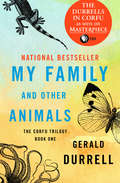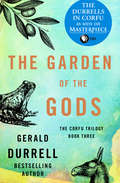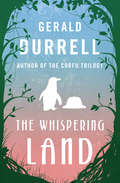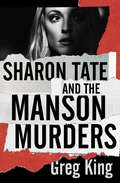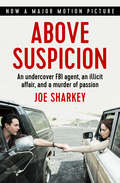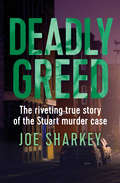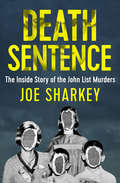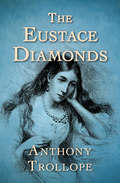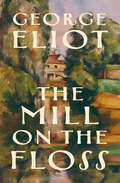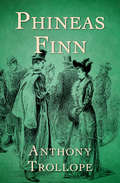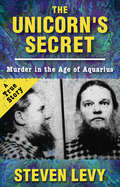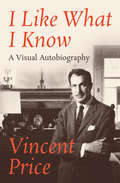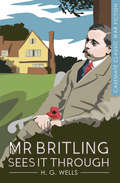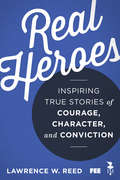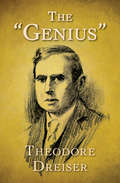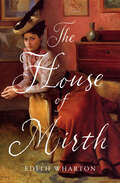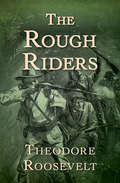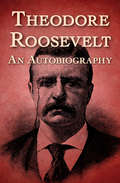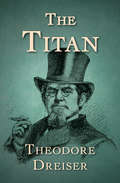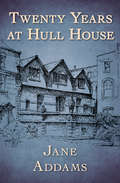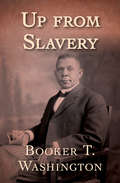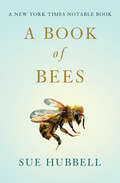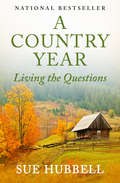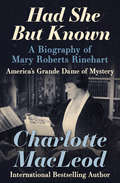- Table View
- List View
My Family and Other Animals (The Corfu Trilogy #1)
by Gerald DurrellThe inspiration for The Durrells in Corfu, a Masterpiece production on public television: A naturalist&’s account of his childhood on the exotic Greek island. When the Durrells could no longer endure the gray English climate, they did what any sensible family would do: sold their house and relocated to the sun-soaked island of Corfu. As they settled into their new home, hilarious mishaps ensued as a ten-year-old Gerald Durrell pursued his interest in natural history and explored the island&’s fauna. Soon, toads and tortoises, bats and butterflies—as well as scorpions, geckos, ladybugs, praying mantises, octopuses, pigeons, and gulls—became a common sight in the Durrell villa. Uproarious tales of the island&’s animals and Durrell&’s fond reflections on his family bring this delightful memoir to life. Capturing the joyous chaos of growing up in an unconventional household, My Family and Other Animals will transport you to a place you won&’t want to leave. This ebook features an illustrated biography of Gerald Durrell including rare photos from the author&’s estate.
The Garden of the Gods: My Family And Other Animals; Birds, Beasts And Relatives; And The Garden Of The Gods (The Corfu Trilogy #3)
by Gerald DurrellPart of the trilogy of memoirs that inspired the television show The Durrells in Corfu: A naturalist&’s adventures with animals—and humans—on a Greek island. When his family moved to a Greek island, young naturalist Gerald Durrell was able to indulge his passion for wildlife of all sorts as he discovered the new world around him—and the creatures and people who inhabited it. Indeed, Durrell&’s years growing up on Corfu would inspire the rest of his life. In addition to his tales of wild animals, Durrell recounts stories about his even wilder family—including his widowed mother, Louisa, and elder siblings Lawrence, Leslie, and Margo—with undeniable wit and humor. The final chapter in Durrell&’s reflections on his family&’s time in Greece before the start of World War II, The Garden of the Gods is a fascinating look at the childhood of a naturalist who was ahead of his time. This ebook features an illustrated biography of Gerald Durrell including rare photos from the author&’s estate.
The Whispering Land: A Zoo In My Luggage, The Whispering Land, And Menagerie Manor (The Zoo Memoirs #2)
by Gerald DurrellNaturalist Gerald Durrell recalls his expedition to South America to find exotic animals in this follow-up to A Zoo in My Luggage. After bringing multiple species of African animals back to the Channel Island of Jersey to populate their new zoo, British naturalist Gerald Durrell and his wife followed their passion for wildlife preservation on a journey to South America. With a team of helpers, they spent eight months on safari searching for exotic specimens. Through windswept Patagonian shores and tropical forests in the Argentine, from ocelots to penguins, fur seals to parrots to pumas, the author who inspired the public television drama The Durrells in Corfu captures the landscape and its inhabitants with his signature charm and humor. Filled with adventure, exploration, and the spirit of conservation, The Whispering Land is a memoir that animal lovers of all ages will enjoy. This ebook features an illustrated biography of Gerald Durrell including rare photos from the author&’s estate.
Sharon Tate and the Manson Murders
by Greg KingThe first comprehensive biography of Sharon Tate: Hollywood star, wife of Roman Polanski, victim of Charles Manson, and symbol of the death of the 1960s. It began as a home invasion by the &“Manson family&” in the early hours of August 9, 1969. It ended in a killing spree that left seven people dead: actress Sharon Tate, writer Voyteck Frykowski, coffee heiress Abigail Folger, hair stylist Jay Sebring, student Steven Parent, and supermarket owner Leno LaBianca and his wife, Rosemary. The shock waves of these crimes still reverberate today. They have also, over time, eclipsed the life of their most famous victim—a Dallas, Texas, beauty queen with Hollywood aspirations. After more than a dozen small film and television roles, Tate gained international fame with the screen adaptation of Jacqueline Susann&’s Valley of the Dolls, but The Fearless Vampire Killers marked a personal turning point, as she would marry its star and director, Roman Polanski. Tate now had a new dream: to raise a family—and she was only weeks away from giving birth the night Charles Manson&’s followers murdered her. Drawn from a wealth of rare material including detective reports, parole transcripts, Manson&’s correspondence, and revealing new interviews with Tate&’s friends and costars as well as surviving relatives of the murder victims, Sharon Tate and the Manson Murders gives readers a vital new perspective on one of the most notorious massacres of the twentieth century. The dark legacy of the cult phenomenon is still being explored in novels (Emma Cline&’s The Girls) and TV shows (NBC&’s Aquarius). In addition to providing the first full-fledged biography of Sharon Tate, author Greg King finally gives a voice to the families of the slain, notably Tate&’s mother, Doris. Her advocacy for victims&’ rights was recognized during President George H. W. Bush&’s 1992 &“A Thousand Points of Light&” ceremony. This is the true story of a star who is being rediscovered by a new generation of fans, a woman who achieved in death the fame she yearned for in life.
Above Suspicion: An Undercover FBI Agent, an Illicit Affair, and a Murder of Passion (Above Suspicion Ser. #Vol. 1)
by Joe SharkeyThe &“uncommonly trenchant account of the only known FBI agent to confess to murder&” (Kirkus Reviews). When rookie FBI agent Mark Putnam received his first assignment in 1987, it was the culmination of a lifelong dream, if not the most desirable location. Pikeville, Kentucky, is high in Appalachian coal country, an outpost rife with lawlessness dating back to the Hatfields and McCoys. As a rising star in the bureau, however, Putnam soon was cultivating paid informants and busting drug rings and bank robbers. But when one informant fell in love with him, passion and duty would collide with tragic results. A coal miner&’s daughter, Susan Smith was a young, attractive, struggling single mother. She was also a drug user sometimes described as a con artist, thief, and professional liar. Ultimately, Putnam gave in to Smith&’s relentless pursuit. But when he ended the affair, she waged a campaign of vengeance that threatened to destroy him. When at last she confronted him with a shocking announcement, a violent scuffle ensued, and Putnam, in a burst of uncontrolled rage, fatally strangled her. Though he had everything necessary to get away with murder—a spotless reputation, a victim with multiple enemies, and the protection of the bureau&’s impenetrable shield—his conscience wouldn&’t allow it. Tormented by a year of guilt and deception, Putnam finally led authorities to Smith&’s remains. This is the story of what happened before, during, and after his startling confession—an account that &“should take its place on the dark shelf of the best American true crime&” (Newsday). Revised and updated, this ebook also includes photos and a new epilogue by the author.
Deadly Greed: The Riveting True Story of the Stuart Murder Case, Which Rocked Boston and Shocked the Nation
by Joe SharkeyThe horrifying account of the Charles Stuart case, in which ambition drove a man to murder his pregnant wife--and blame a fictitious African-American killer. On October 23, 1989, affluent businessman Charles Stuart made a frantic 911 call from his car to report that he and his seven-months-pregnant wife, Carol, a lawyer, had been robbed and shot by a black male in the Mission Hill neighborhood of Boston. By the time police arrived, Carol was dead, and the baby was soon lost as well. The attack incited a furor during a time of heightened racial tension in the community. Even more appalling, while the injuries were real, Stuart's story was a hoax: He was the true killer. But the tragedy would continue with the arrest of Willie Bennett, a young man Stuart identified in a line-up. Stuart's deception would only be exposed after a shocking revelation from his brother and, finally, his suicide, when he jumped into the freezing waters of the Mystic River. As the story unraveled, police would put together the disturbing pieces of a puzzle that included Stuart's distress over his wife's pregnancy, his romantic interest in a coworker, and life insurance fraud. In an account that "builds and grips like a novel" (Kirkus Reviews), New York Times journalist Joe Sharkey delivers "a picture of a man consumed by naked ambition, unwilling to let anyone or anything get in his way" (Library Journal). Revised and updated, this ebook also includes photos and a new epilogue by the author.
Death Sentence: The Inside Story of the John List Murders
by Joe SharkeyThe true account of the man who murdered his family in their New Jersey mansion—and eluded a nationwide manhunt for eighteen years. Until 1971, life was good for mild-mannered accountant John List. He was vice president of a Jersey City bank and had moved his mother, wife, and three teenage children into a nineteen-room home in Westfield, New Jersey. But all that changed when he lost his job. Raised by his Lutheran father to believe success meant being a good provider, List saw himself as an utter failure. Straining under financial burdens, the stress of hiding his unemployment, as well as the fear that the free-spirited 1970s would corrupt the souls of his children, List came to a shattering conclusion. &“It was my belief that if you kill yourself, you won&’t go to heaven,&” List told Connie Chung in a television interview. &“So eventually I got to the point where I felt that I could kill them. Hopefully they would go to heaven, and then maybe I would have a chance to later confess my sins to God and get forgiveness.&” List methodically shot his entire family in their home, managing to conceal the deaths for weeks with a carefully orchestrated plan of deception. Then he vanished and started over as Robert P. Clark. Chronicling List&’s life before and after the grisly crime, Death Sentence exposes the truth about the accountant-turned-killer, including his revealing letter to his pastor, his years as a fugitive with a new name—and a new wife—his eventual arrest, and the details of his high-profile trial. Revised and updated, this ebook also includes photos.
The Eustace Diamonds: Third Of The Palliser Novels (The Palliser Novels #3)
by Anthony TrollopeFor an ambitious, keenly intelligent woman, lying proves to be the easiest way to get through life, in this Victorian-era classic. Lizzie Greystock is a woman of rare cunning and determination—both of which she uses to better her lot in life. This is especially true when she manages to convince the ailing Sir Florian Eustace to marry her shortly before his demise, leaving Lizzie both a wealthy widow and the mother to Florian&’s young son. A born deceiver, Lizzie is easily able to keep up the front of a proper mourning widow. But while her inherited wealth provides her with comfort, her true love is saved for the opulent diamond necklace her late husband gifted to her. Though it is a family heirloom, she adamantly refuses to give it up, and it soon becomes the focus of her life and the lives of those around her. The story of one woman&’s ability to mask her true self and manipulate those who would do the same, TheEustace Diamonds shows the true mastery of witty storytelling and social mores that made Anthony Trollope a revered author. The Eustace Diamonds is the 3rd book in the Palliser Novels, but you may enjoy reading the series in any order. This ebook has been professionally proofread to ensure accuracy and readability on all devices.
The Mill on the Floss: Large Print
by George EliotThe classic tale of one young woman&’s quest for fulfillment in 1820s England, and the price she would pay for true freedom. Maggie Tulliver&’s entire life has been spent in the shadow of Dorlcote Mill on the River Floss with her beloved older brother, Tom. But when their father meets an untimely death, the siblings&’ singular bond is strained as Tom is forced to leave his studies and Maggie struggles to find a sense of belonging. Maggie&’s sharp intelligence and spirited nature have made her an oddity in the rural hamlet of St. Ogg&’s, where such unique qualities are perceived as unbecoming for a woman. Her need for recognition and love eventually drives her to defy her brother, who casts her out of his house to survive on her own. Forced to grieve the losses of both their father and each other, the siblings will have to find it in their hearts to forgive in order to reconcile before tragedy strikes again. Inspired by events in the life of the author, The Mill on the Floss is George Eliot&’s most heartfelt novel and one of her most compelling and moving works. This ebook has been professionally proofread to ensure accuracy and readability on all devices.
Phineas Finn: The Irish Member, Volume 3 (The Palliser Novels #2)
by Anthony TrollopeAn adventurous Irishman sets out to find his fortune among proper English society in this classic novel from Anthony Trollope. Sent to London to become a lawyer, young Phineas Finn proves himself to be a disappointing student but truly gifted in the ways of charm, culture, and fine appearance. It is the discovery of these talents that ultimately leads him to what he believes is his true calling: English Parliament. Through sheer luck and pluck, dashing, innocent Phineas is able to win a seat on the bench, but the real journey begins as he tours the labyrinthine halls of those who hold sway over their fellow men—and the practical and romantic quandaries he must navigate if he is to advance himself. Finding both victory and defeat, love and loneliness, the path Phineas strides is one of confidence and humanity as he seeks to fulfill his wants and desires while holding true to his convictions both in his own life and in the ever-changing arena of political expediency. In Phineas Finn, Anthony Trollope invites readers to follow an irrepressible, good-minded protagonist in a comical, exciting, heartbreaking tale that resonates as much today as it did upon its first publication. Phineas Finn is the 2nd book in the Palliser Novels, but you may enjoy reading the series in any order. This ebook has been professionally proofread to ensure accuracy and readability on all devices.
The Unicorn's Secret: Murder in the Age of Aquarius (Onyx Series)
by Steven LevyThe true story of Ira Einhorn, the Philadelphia antiwar crusader, environmental activist, and New Age guru with a murderous dark side. During the cultural shockwaves of the 1960s and '70s, Ira Einhorn--nicknamed the "Unicorn"--was the leading radical voice for the antiwar movement at the University of Pennsylvania. At his side were such noted activists as Abbie Hoffman and Jerry Rubin. A brilliantly articulate advocate for peace in a turbulent era, he rallied followers toward the growing antiestablishment causes of free love, drugs, and radical ecological reform. In 1979, when the mummified remains of his girlfriend, Holly Maddux, a Bryn Mawr flower child from Tyler, Texas, were found in a trunk in his apartment, Einhorn claimed a CIA frame-up. Incredibly, the network of influential friends, socialites, and powerful politicians he'd charmed and manipulated over the years supported him. Represented by renowned district attorney and future senator Arlen Specter, Einhorn was released on bail. But before trial, he fled the country to an idyllic town in the French wine region and disappeared. It would take more than twenty years--and two trials--to finally bring Einhorn to justice. Based on more than two years of research and 250 interviews, as well as the chilling private journals of Einhorn and Maddux, prize-winning journalist Steven Levy paints an astonishing and complicated portrait of a man motivated by both genius and rage. The basis for 1998 NBC television miniseries The Hunt for the Unicorn Killer, The Unicorn's Secret is a "spellbinding sociological/true crime study," revealing the dark and tragic dimensions of a man who defined an era, only to shatter its ideals (Publishers Weekly).
I Like What I Know: A Visual Autobiography
by Vincent PricePublished in 1959, this book is what Vincent Price called his "visual autobiography" -- the story of his life through his 48th year as seen through the lens of his greatest passion, the visual arts. Peppered with lively stories about both his art collecting and advocacy as well as his career as an actor, I Like What I Know is written in an approachable and entertaining style, capturing what has drawn fans to Vincent Price throughout his distinguished 65-year-career and in the two decades since his death in 1993.
Mr. Britling Sees It Through: A Novel (Casemate Classic War Fiction #7)
by H. G. WellsA moving novel of one Englishman&’s experience as his country goes to war, from the author of who gave us The Time Machine and The Invisible Man. Mr. Britling considers himself an optimist. But as the Great War begins, he finds himself forced to reassess many of the things he thought he was sure of. As refugees from Belgium arrive in the town of Matching&’s Easy, telling frightening tales of what they have seen, Mr. Britling sees men dressed in khakis everywhere he looks. and his family&’s tutor, a German, is forced to return home. Then comes the change that scares him the most: His own son, Hugh, only seventeen, enlists in the Territorials, the British Army&’s volunteer reserve. Day by day and month by month, Britling observes the unfolding events and public reaction to the war as his ordinary life is shaken in ways large and small. As Wells&’s characters try to keep their bearings in a world suddenly changed beyond recognition, Mr. Britling must wrestle with outrage, grief, and attempts at rationalization as he resolves to &“see it through.&” Whether science fiction or not, H. G. Wells&’s stories always reflect deep human truths. Written in 1916, when the outcome of the conflict was still uncertain, this is both a fascinating portrait of Britain at war and a rare inside look at H. G. Wells himself, as Mr. Britling was a largely autobiographical character.
Real Heroes
by Lawrence W ReedCharacter is indispensable to a successful career and a happy life. It's also essential to our liberty, because if a society can't govern itself, then government must step in to police our decisions and actions. Sounds pretty heavy, right? Well, the good news is that character is nothing more than the sum of our choices, and it is something every one of us has total control over. And here's even better news: this book gives us flesh-and-blood models--men and women whose choices and actions make them heroes. The forty people Lawrence W. Reed profiles in this accessible, inspirational book are not the usual examples. Some are well-known historical and cultural figures, yes--but Real Heroes also features many remarkable people you have never heard of. Reed ranges far and wide--from the distant past to the present; from the United States, to Europe, to Asia; from statesmen to scientists, athletes to inventors, entrepreneurs to theologians, and writers to teachers. Concise and compelling, Real Heroes features a bulleted summary of key facts and takeaways at the end of each profile. This book will become a treasured resource for parents and teachers and a favorite of readers of all ages.
Right Tool for the Job: A Memoir of Manly Concerns
by Mark GoldblattManhood today is under siege--regarded as an object of menace on college quads, associated with various forms of real and imagined oppression, ridiculed in humanities departments, parodied by sitcoms and commercials, and shriveled to a raisin-sized remnant by psychosexual theorizing. But while manhood may be under attack in a sociopolitical context, it remains very much a living idea which every penis-endowed person must wrestle with over the course of his lifetime. The Right Tool for the Job is a comic account of one man's struggle to honor his testosterone heritage--with varying results.
The "Genius"
by Theodore DreiserThe gritty, controversial story of a life devoted to art and sensuality from the Nobel Prize–winning author of Sister Carrie and An American Tragedy. Driven to experience life beyond the small Illinois town of his youth, Eugene Witla makes his way to Chicago, where he is immediately drawn to the buzz of the city and the sexual freedom of bohemian life. At the Chicago Art Institute, he studies painting, soon making a name for himself as a gifted urban realist. Throughout his life, Witla’s commitment to his art is rivaled only by his need for erotic adventure. In love and marriage, and from Chicago to New York to the cities of Europe, Witla finds himself at odds with convention and pays a profound cost for his struggle. First published in 1915, The “Genius”, Theodore Dreiser’s most personal and provocative novel, was declared obscene by the New York Society for the Suppression of Vice, and under threat of legal action, it was recalled from bookstores. Rereleased in 1923, it went on to establish Dreiser’s reputation as a writer ahead of his time, giving unparalleled insight into the mind of a prodigy. This ebook has been professionally proofread to ensure accuracy and readability on all devices.
The House of Mirth
by Edith WhartonThe classic tale of a young woman’s struggle for love and money from the Pulitzer Prize–winning author of Ethan Frome and The Age of Innocence. Raised among New York’s high society, Lily Bart is beautiful, charming, and entirely without means. Determined to maintain the extravagant lifestyle to which she is accustomed, Lily embarks on a mission to marry a wealthy man who can secure her station. However, the businesslike proposals from her many suitors remain fruitless, and her thoughts keep returning to the one man she truly loves. Bedeviled by debt, betrayal, and vicious gossip, she is forced to confront the tragic cruelty just beneath the surface of the Gilded Age. First appearing in Scribner’s Magazine as a monthly serial, The House of Mirth was a runaway bestseller upon its release as a full-length novel in 1905. Hailed as “a fireworks display of brilliantly sardonic social satire deepened by a story of thwarted love” by the Wall Street Journal, it was the first popular and critical success for Edith Wharton, who went on to become the first female author to win the Pulitzer Prize. Since its initial publication, The House of Mirth has been adapted into two feature films and continues to captivate modern readers. This ebook has been professionally proofread to ensure accuracy and readability on all devices.
The Rough Riders
by Theodore RooseveltTheodore Roosevelt’s bestselling memoir chronicling the 1st United States Volunteer Cavalry and its victory at San Juan Hill in the Spanish-American War. Yearning to join the fight for Cuban independence in the Spanish–American War, Theodore Roosevelt and Col. Leonard Wood formed the 1st United States Volunteer Cavalry. They enlisted a motley crew from all walks of life, from cowboys and frontiersmen to Ivy League graduates. These 1,250 men became known as the Rough Riders. After training in San Antonio, Texas, they set out for the tropical jungles of Cuba. As they grappled with hunger, malaria, and occasional defeat, their many battles with the Spanish Army culminated in the death-defying charge to victory at San Juan Hill. Through it all, Roosevelt kept a pocket diary in which he made daily entries about his experiences and the men who fought beside him. Imbued with his trademark vigor and certainty of purpose, Roosevelt’s firsthand account of this historic campaign paints a vivid picture of the rugged, independent spirit that came to define American heroism. This ebook has been professionally proofread to ensure accuracy and readability on all devices.
Theodore Roosevelt
by Theodore RooseveltThe firsthand account of the life of adventurer, scholar, war hero, and twenty-sixth president of the United States Theodore Roosevelt.There must be the keenest sense of duty, and with it must go the joy of living. Here, in his own words, Theodore Roosevelt recounts his remarkable journey from a childhood plagued with illnesses to the US presidency and beyond. With candor and vivid detail, this personal account describes a life guided by a restless intelligence, a love for adventure, and an unflagging duty to his country. Roosevelt sheds light on his wide array of roles, from New York police commissioner, where he waged a battle against corruption, to cattle rancher in the Dakotas to assistant secretary of the US Navy under William McKinley to leader of the legendary Rough Riders at the outbreak of the Spanish–American War, when he led the 1st United States Volunteer Cavalry to victory in the Battle of San Juan Hill. These extraordinary accomplishments earned Roosevelt national fame and set the stage for his ascent to the White House. As twenty-sixth president of the United States, he ushered in the Progressive Era with his domestic policies, such as the Square Deal, and trust-busting of monopolies, such as Standard Oil. He was a war hero, scholar, statesman, adventurer, and Nobel Peace Prize winner. Theodore Roosevelt: An Autobiography provides unique insight into the truly remarkable life of one of America’s most beloved presidents. This ebook has been professionally proofread to ensure accuracy and readability on all devices.
The Titan
by Theodore DreiserThe second novel in the Trilogy of Desire from the author of The Financier and Sister Carrie. In the Panic of 1873, Frank Cowperwood’s fortune was destroyed and his criminal activity on the stock exchange was exposed. Now, with his prison sentence complete, he is ready to begin the next chapter of his life. Following the same creed of selfishness that guided him to his first fortune, Cowperwood leaves Philadelphia for Chicago and gives up financial speculation to pursue a new frontier. Though he soon rediscovers wealth in stock investment, he remains hounded by scandal as he maneuvers to take control of the Chicago railway system. Through double-dealing, divorce, infidelity, and social disgrace, America’s most corrupt man continues his lifelong pursuit of self-satisfaction. In the sequel to The Financier, Theodore Dreiser presents a man of indomitable force and pitiless ambition. Based on railway tycoon Charles Tyson Yerkes, Frank Cowperwood is widely considered one of the greatest characters of twentieth-century literature. This ebook has been professionally proofread to ensure accuracy and readability on all devices.
Twenty Years at Hull House
by Jane AddamsThe classic memoir of one of the Progressive Era’s most important reformers and social activists. If it is natural to feed the hungry . . . it is certainly natural to give pleasure to the young, comfort to the aged, and to minister to the deep-seated craving for social intercourse that all men feel. In 1889, Jane Addams and her partner, Ellen Starr, opened the first settlement house in the United States. On Chicago’s West Side, Hull House was devoted to the city’s poor and forgotten, from immigrants and unwed mothers to the elderly, homeless, and hungry. Its charter proclaimed its mission “to provide a center for higher civic and social life, to institute and maintain educational and philanthropic enterprises, and to investigate and improve the conditions in the industrial districts of Chicago.” In Twenty Years at Hull House, Addams chronicles her revolutionary work from its conception in the Gilded Age through the dawn of the Progressive Era. A cofounder of the American Civil Liberties Union and the first American woman to win the Nobel Peace Prize, Addams devoted her life to realizing a more noble vision of democracy. More than a personal memoir, Twenty Years at Hull-House is a landmark document of social theory and political history. This ebook has been professionally proofread to ensure accuracy and readability on all devices.
Up from Slavery
by Booker T. WashingtonBooker T. Washington’s classic memoir of enslavement, emancipation, and community advancement in the Reconstruction Era. Born into slavery on a tobacco farm in nineteenth-century Virginia, Booker T. Washington became one of the most powerful intellectuals of the Reconstruction Era. As president of the Tuskegee Institute in Alabama, he advocated for the advancement of African Americans through education and entrepreneurship. In Up from Slavery, Washington speaks frankly and honestly about his enslavement and emancipation, struggle to receive an education, and life’s work as an educator. In great detail, Washington describes establishing the Tuskegee Institute, from teaching its first classes in a hen house to building a prominent institution through community organization and a national fundraising campaign. He also addresses major issues of the era, such as the Jim Crow laws, Ku Klux Klan, and “false foundation” of Reconstruction policy. Up From Slavery is based on biographical articles written for the Christian newspaper Outlook and includes the full text of Washington’s revolutionary Atlanta Exposition address. First published in 1901, this powerful autobiography remains a landmark of African American literature as well as an important firsthand account of post–Civil War American history. This ebook has been professionally proofread to ensure accuracy and readability on all devices.
A Book of Bees: And How To Keep Them
by Sam Potthoff Sue HubbellA New York Times Notable Book: "A melodious mix of memoir, nature journal, and beekeeping manual" (Kirkus Reviews). Weaving a vivid portrait of her own life and her bees' lives, author Sue Hubbell lovingly describes the ins and outs of beekeeping on her small Missouri farm, where the end of one honey season is the start of the next. With three hundred hives, Hubbell stays busy year-round tending to the bees and harvesting their honey, a process that is as personally demanding as it is rewarding. Exploring the progression of both the author and the hive through the seasons, this is "a book about bees to be sure, but it is also about other things: the important difference between loneliness and solitude; the seasonal rhythms inherent in rural living; the achievement of independence; the accommodating of oneself to nature" (ThePhiladelphia Inquirer). Beautifully written and full of exquisitely rendered details, it is a tribute to Hubbell's wild hilltop in the Ozarks and of the joys of living a complex life in a simple place.
A Country Year: Living the Questions
by Sue HubbellA &“delightful, witty&” memoir about starting over as a beekeeper in the Ozarks (Library Journal). Alone on a small Missouri farm after a thirty-year marriage, Sue Hubbell found a new love—of the winged, buzzing variety. Left with little but the commercial beekeeping and honey-producing business she started with her husband, Hubbell found solace in the natural world. Then she began to write, challenging herself to tell the absolute truth about her life and the things she cared about. Describing the ups and downs of beekeeping from one springtime to the next, A Country Year transports readers to a different, simpler place. In a series of exquisite vignettes, Hubbell reveals the joys of a life attuned to nature in this heartfelt memoir about life on the land, and of a woman finding her way in middle age. &“Once in a while there comes along a book so calm, so honest, so beautiful that even the most jaded or cynical readers have to say thank you. . . . This is such a book&” (The San Diego Union-Tribune).
Had She But Known: A Biography of Mary Roberts Rinehart
by Charlotte MacLeodBefore Agatha Christie, there was America&’s Mistress of Mystery. This is the story of her life and creative legacy, from the butler who did it to Batman. In the decades since her death in 1958, master storyteller Mary Roberts Rinehart has often been compared to Agatha Christie. But while Rinehart was once a household name, today she is largely forgotten. The woman who first proclaimed &“the butler did it&” was writing for publication years before Christie&’s work saw the light of day. She also practiced nursing, became a war correspondent, and wrote a novel—The Bat—that inspired Bob Kane&’s creation of Batman. Born in Allegheny City, Pennsylvania, before it was absorbed into Pittsburgh, and raised in a close-knit Presbyterian family, Mary Roberts was at once a girl of her time—dutiful, God-fearing, loyal—and a quietly rebellious spirit. For every hour she spent cooking, cleaning, or sewing at her mother&’s behest while her &“frail&” younger sister had fun, Mary eked out her own moments of planning, dreaming, and writing. But becoming an author wasn&’t on her radar . . . yet. Bestselling mystery writer Charlotte MacLeod grew up on Rinehart&’s artfully crafted novels, such as the enormously successful The Circular Staircase—&“cozies&” before the concept existed. After years of seeing Christie celebrated and Rinehart overlooked, MacLeod realized that it was time to delve into how this seemingly ordinary woman became a sensation whose work would grace print, stage, and screen. From Rinehart&’s grueling training as a nurse and her wartime interviews with a young Winston Churchill and Queen Mary to her involvement with the Blackfoot Indians and her work as doctor&’s wife, mother of three, playwright, serialist, and novelist, this is the unforgettable story of America&’s Grande Dame of Mystery.
